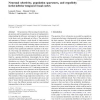Free Online Productivity Tools
i2Speak
i2Symbol
i2OCR
iTex2Img
iWeb2Print
iWeb2Shot
i2Type
iPdf2Split
iPdf2Merge
i2Bopomofo
i2Arabic
i2Style
i2Image
i2PDF
iLatex2Rtf
Sci2ools
85
Voted
BC
2007
2007
Neuronal selectivity, population sparseness, and ergodicity in the inferior temporal visual cortex
Abstract Thesparsenessoftheencodingofstimulibysingle neurons and by populations of neurons is fundamental to understanding the efficiency and capacity of representations in the brain, and was addressed as follows. The selectivity and sparseness of firing to visual stimuli of single neurons in the primate inferior temporal visual cortex were measured to a set of 20 visual stimuli including objects and faces in macaques performing a visual fixation task. Neurons were analysed with significantly different responses to the stimuli. The firing rate distribution of 36% of the neurons was exponential. Twenty-nine percent of the neurons had too few low rates to be fitted by an exponential distribution, and were fitted by a gamma distribution. Interestingly, the raw firing rate distribution taken across all neurons fitted an exponential distribution very closely. The sparseness as or selectivity of the representation of the set of 20 stimuli provided by each
Related Content
| Added | 08 Dec 2010 |
| Updated | 08 Dec 2010 |
| Type | Journal |
| Year | 2007 |
| Where | BC |
| Authors | Leonardo Franco, Edmund T. Rolls, Nikolaos C. Aggelopoulos, José M. Jerez |
Comments (0)

